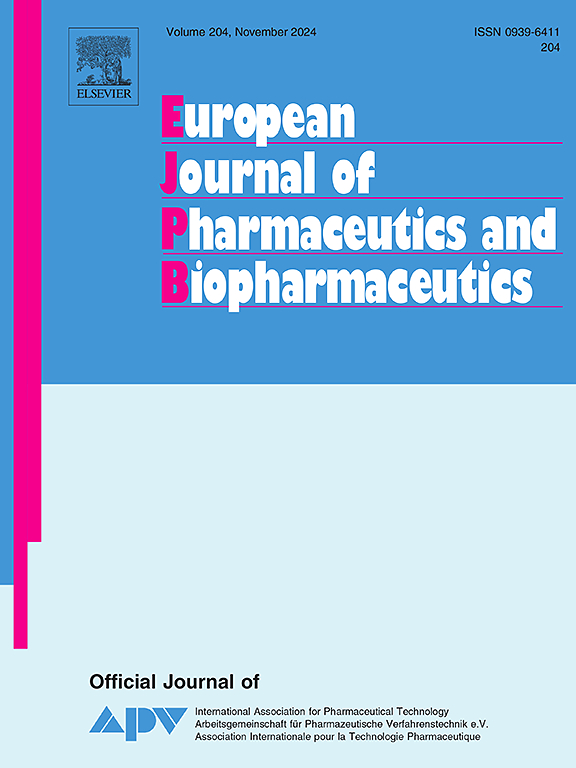不同电磁场对萘普生透皮通透性的影响及活性化合物暴露对磁场特性的影响
IF 4.3
2区 医学
Q1 PHARMACOLOGY & PHARMACY
European Journal of Pharmaceutics and Biopharmaceutics
Pub Date : 2025-05-23
DOI:10.1016/j.ejpb.2025.114715
引用次数: 0
摘要
透皮给药系统是口服给药的一个有希望的替代方案,尽管改善活性药物成分(api)的皮肤渗透性仍然具有挑战性。本研究考察了不同电磁场对萘普生透皮性及其理化性质的影响。以猪皮为模型,在振荡、脉冲、静态和旋转磁场(RMF)下测试NAP的磁导率,并与没有电磁场暴露的对照组进行比较。结果显示,不同EMF类型的NAP渗透率存在显著差异,50 Hz RMF产生的最高累积渗透质量(CPM)为1461.40±256.15µg/cm2,而对照组的CPM为267.57±41.74µg/cm2。RMF 50 Hz也使稳态通量(JSS)和渗透系数(KP)最大化,突出了其增强透皮给药的潜力。相反,具有负极化的静态磁场降低了磁导率,显示出磁场与皮肤磁导率之间复杂的相互作用。研究还发现,RMF治疗降低了NAP皮肤积聚,提高了渗透效率。理化分析(FTIR、XRD、溶解度和亲脂性)表明,虽然EMF暴露对NAP的晶体结构没有显著影响,但会影响溶解度和分配系数。这项研究强调了优化电磁场参数以增强经皮药物传递的潜力,并提供了电磁场与活性化合物之间的物理化学相互作用的见解。研究结果表明,旋转磁场,特别是50赫兹的磁场,可以显著提高药物的渗透性,这可能有利于开发先进的透皮给药系统。本文章由计算机程序翻译,如有差异,请以英文原文为准。

Impact of various electromagnetic fields on the transdermal permeability of naproxen and the effect of active compound exposure on magnetic field properties
Transdermal drug delivery systems present a promising alternative to oral administration, though improving skin permeability of active pharmaceutical ingredients (APIs) remains challenging. This study examines how various electromagnetic fields (EMFs) affect the transdermal permeability of naproxen (NAP) and its physicochemical properties. Using pigskin as a model, NAP permeability was tested under oscillating, pulsed, static, and rotating magnetic fields (RMF), compared to a control group without EMF exposure. The results show significant differences in NAP permeability depending on EMF type, with RMF at 50 Hz yielding the highest cumulative permeation mass (CPM) of 1461.40 ± 256.15 µg/cm2, compared to 267.57 ± 41.74 µg/cm2 for the control. RMF 50 Hz also maximized steady-state flux (JSS) and permeability coefficient (KP), highlighting its potential for enhanced transdermal delivery. Conversely, static magnetic fields with negative polarization reduced permeation, showing a complex interaction between magnetic fields and skin permeability. The study also found that RMF treatments lowered NAP skin accumulation, improving permeation efficiency. Physicochemical analyses (FTIR, XRD, solubility, and lipophilicity) revealed that while EMF exposure did not significantly change NAP’s crystal structure, it did affect solubility and partition coefficient. This research highlights the potential of optimizing EMF parameters to enhance transdermal drug delivery and provides insights into the physicochemical interactions between EMFs and active compounds. The findings suggest that rotating magnetic fields, particularly at 50 Hz, offer the most significant improvement in drug permeability, which could be beneficial for developing advanced transdermal delivery systems.
求助全文
通过发布文献求助,成功后即可免费获取论文全文。
去求助
来源期刊
CiteScore
8.80
自引率
4.10%
发文量
211
审稿时长
36 days
期刊介绍:
The European Journal of Pharmaceutics and Biopharmaceutics provides a medium for the publication of novel, innovative and hypothesis-driven research from the areas of Pharmaceutics and Biopharmaceutics.
Topics covered include for example:
Design and development of drug delivery systems for pharmaceuticals and biopharmaceuticals (small molecules, proteins, nucleic acids)
Aspects of manufacturing process design
Biomedical aspects of drug product design
Strategies and formulations for controlled drug transport across biological barriers
Physicochemical aspects of drug product development
Novel excipients for drug product design
Drug delivery and controlled release systems for systemic and local applications
Nanomaterials for therapeutic and diagnostic purposes
Advanced therapy medicinal products
Medical devices supporting a distinct pharmacological effect.

 求助内容:
求助内容: 应助结果提醒方式:
应助结果提醒方式:


